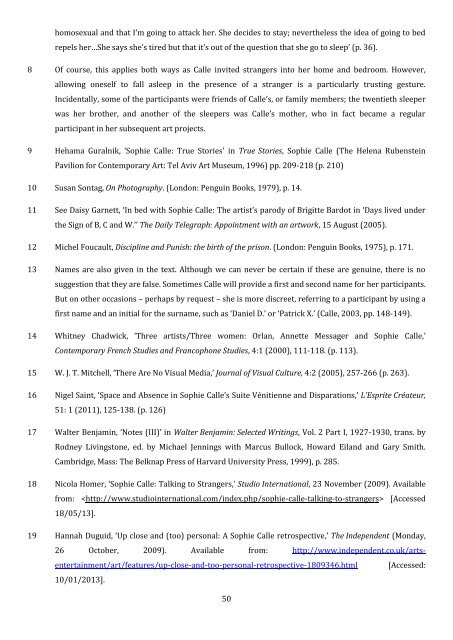download this issue as a PDF
download this issue as a PDF
download this issue as a PDF
Create successful ePaper yourself
Turn your PDF publications into a flip-book with our unique Google optimized e-Paper software.
homosexual and that I’m going to attack her. She decides to stay; nevertheless the idea of going to bed<br />
repels her…She says she’s tired but that it’s out of the question that she go to sleep’ (p. 36).<br />
8 Of course, <strong>this</strong> applies both ways <strong>as</strong> Calle invited strangers into her home and bedroom. However,<br />
allowing oneself to fall <strong>as</strong>leep in the presence of a stranger is a particularly trusting gesture.<br />
Incidentally, some of the participants were friends of Calle’s, or family members; the twentieth sleeper<br />
w<strong>as</strong> her brother, and another of the sleepers w<strong>as</strong> Calle’s mother, who in fact became a regular<br />
participant in her subsequent art projects.<br />
9 Hehama Guralnik, ‘Sophie Calle: True Stories’ in True Stories, Sophie Calle (The Helena Rubenstein<br />
Pavilion for Contemporary Art: Tel Aviv Art Museum, 1996) pp. 209-218 (p. 210)<br />
10 Susan Sontag, On Photography. (London: Penguin Books, 1979), p. 14.<br />
11 See Daisy Garnett, ‘In bed with Sophie Calle: The artist’s parody of Brigitte Bardot in ‘Days lived under<br />
the Sign of B, C and W.’’ The Daily Telegraph: Appointment with an artwork, 15 August (2005).<br />
12 Michel Foucault, Discipline and Punish: the birth of the prison. (London: Penguin Books, 1975), p. 171.<br />
13 Names are also given in the text. Although we can never be certain if these are genuine, there is no<br />
suggestion that they are false. Sometimes Calle will provide a first and second name for her participants.<br />
But on other occ<strong>as</strong>ions – perhaps by request – she is more discreet, referring to a participant by using a<br />
first name and an initial for the surname, such <strong>as</strong> ‘Daniel D.’ or ‘Patrick X.’ (Calle, 2003, pp. 148-149).<br />
14 Whitney Chadwick, ‘Three artists/Three women: Orlan, Annette Messager and Sophie Calle,’<br />
Contemporary French Studies and Francophone Studies, 4:1 (2000), 111-118. (p. 113).<br />
15 W. J. T. Mitchell, ‘There Are No Visual Media,’ Journal of Visual Culture, 4:2 (2005), 257-266 (p. 263).<br />
16 Nigel Saint, ‘Space and Absence in Sophie Calle’s Suite Vénitienne and Disparations,’ L’Esprite Créateur,<br />
51: 1 (2011), 125-138. (p. 126)<br />
17 Walter Benjamin, ‘Notes (III)’ in Walter Benjamin: Selected Writings, Vol. 2 Part I, 1927-1930, trans. by<br />
Rodney Livingstone, ed. by Michael Jennings with Marcus Bullock, Howard Eiland and Gary Smith.<br />
Cambridge, M<strong>as</strong>s: The Belknap Press of Harvard University Press, 1999), p. 285.<br />
18 Nicola Homer, ‘Sophie Calle: Talking to Strangers,’ Studio International, 23 November (2009). Available<br />
from: [Accessed<br />
18/05/13].<br />
19 Hannah Duguid, ‘Up close and (too) personal: A Sophie Calle retrospective,’ The Independent (Monday,<br />
26 October, 2009). Available from: http://www.independent.co.uk/artsentertainment/art/features/up-close-and-too-personal-retrospective-1809346.html<br />
[Accessed:<br />
10/01/2013].<br />
50
















